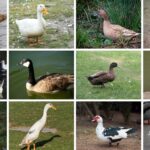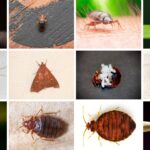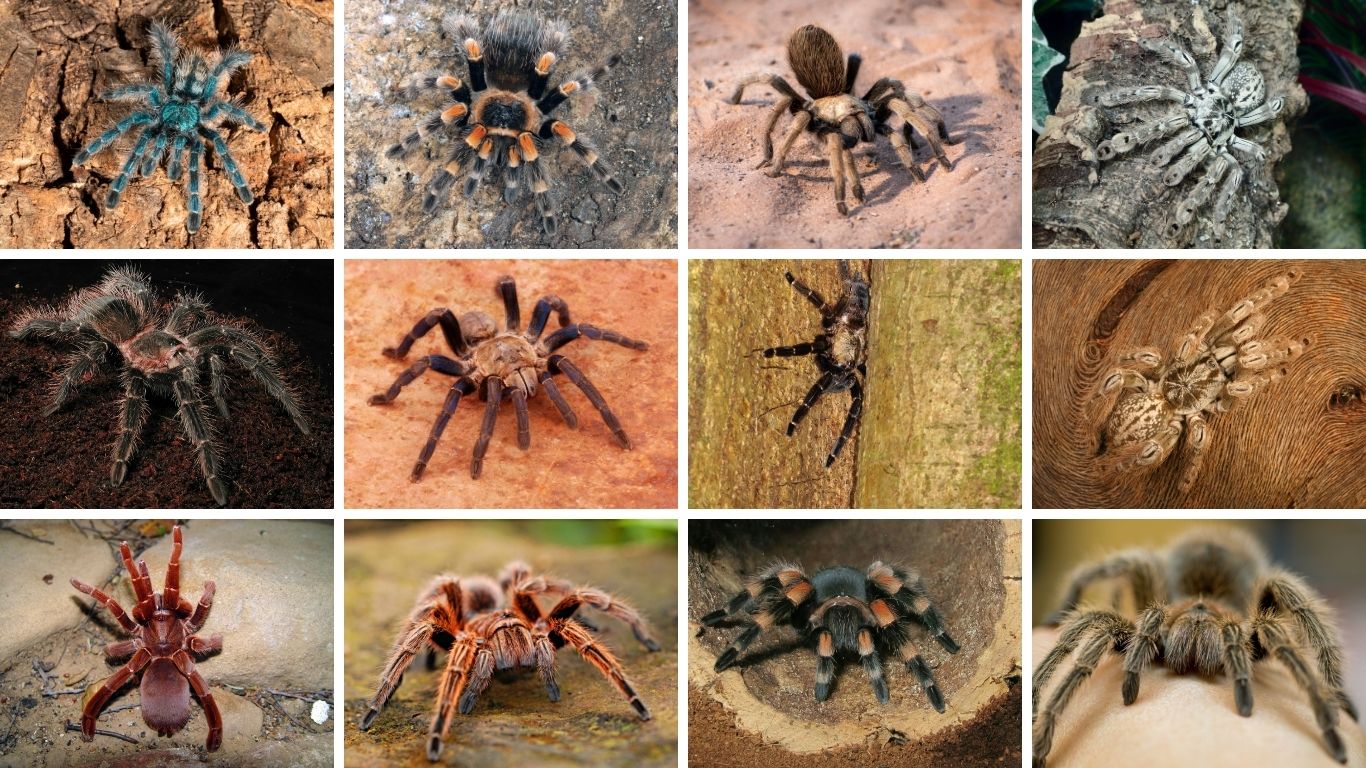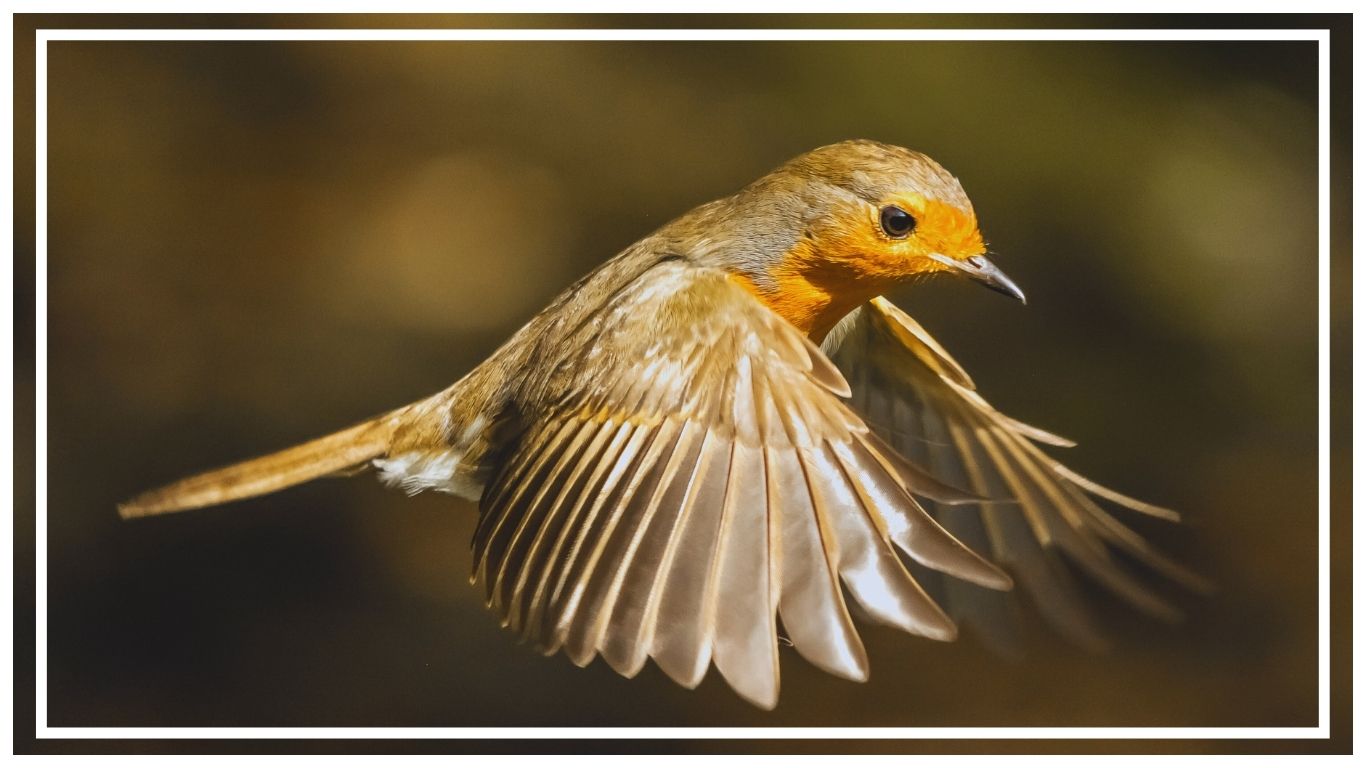From the rainforest floors of South America to the dry deserts of Africa, the world’s largest spiders come in all shapes and shades. Ranked by leg span and body mass, these giants showcase nature’s extremes—from the massive Goliath Birdeater to the vividly colored Antilles Pinktoe. Explore 17 of the biggest spiders ever recorded, each more fascinating than the last.
1. Goliath Birdeater

The Goliath Birdeater (Theraphosa blondi) holds the record as the largest spider in the world by mass and body size. Native to the rainforests of northern South America, this tarantula can weigh over 170 grams and has a leg span reaching up to 12 inches (30 cm). Its enormous size and hairy appearance make it an intimidating predator in the wild, though it rarely poses a danger to humans.
Identification
- Leg span: Up to 12 inches (30 cm)
- Body length: Around 4.75 inches (12 cm)
- Weight: Up to 170 grams
- Color: Brown to reddish-brown with bristly hairs
- Fangs: Over 1 inch long
Habitat
The Goliath Birdeater is found primarily in the deep rainforests of Venezuela, Brazil, Guyana, and Suriname. It lives in burrows and prefers moist, swampy areas.
Behavior
Despite its name, this spider rarely eats birds. It primarily feeds on insects, frogs, small mammals, and sometimes earthworms. It uses ambush tactics and its size to overpower prey.
Region
Northern South America — especially the Amazon basin and surrounding rainforest regions.
2. Giant Huntsman Spider

The Giant Huntsman Spider (Heteropoda maxima) is recognized for having the largest leg span of any known spider—measuring up to 12 inches (30 cm). Unlike the Goliath Birdeater, its body is smaller, but its long, crab-like legs make it look enormous. Discovered in a cave in Laos in 2001, this fast and agile hunter is more elusive than most large spiders.
Identification
- Leg span: Up to 12 inches (30 cm)
- Body length: Around 2 inches (5 cm)
- Weight: Less than the Goliath Birdeater
- Color: Pale beige to brown with dark spots
- Eye pattern: Eight eyes in two rows
Habitat
Typically found in limestone caves and forested areas. It prefers dark, damp environments with hiding places among rocks and bark.
Behavior
It does not spin webs to trap prey. Instead, it actively hunts insects and small creatures using its speed and long legs to overpower them.
Region
Native to Laos, Southeast Asia. It thrives in the humid, forested cave systems of this tropical region and may also be found in surrounding parts of Indo-China.
3. Brazilian Salmon Pink Birdeater

The Brazilian Salmon Pink Birdeater (Lasiodora parahybana) is among the heaviest spiders, often growing a leg span of 10 to 11 inches (25–28 cm). It’s named for the salmon-colored hairs that cover its legs and body. This spider grows fast and is popular in the exotic pet trade due to its size and hardiness.
Identification
- Leg span: 10–11 inches (25–28 cm)
- Body length: About 3.5–4 inches (9–10 cm)
- Weight: Up to 100 grams
- Color: Blackish with pink to salmon hairs
- Distinctive traits: Dense hair and heavy body
Habitat
This tarantula inhabits humid, tropical forests and grasslands. It prefers to burrow in soft soil and may create shelters under logs or leaf litter.
Behavior
It’s a ground-dwelling ambush predator, feeding on insects, lizards, and even small rodents. Though large, it is generally docile in captivity.
Region
Native to northeastern Brazil, particularly in the Paraíba region, where the climate is warm and moist, ideal for tarantula burrowing behavior.
4. Grammostola anthracina
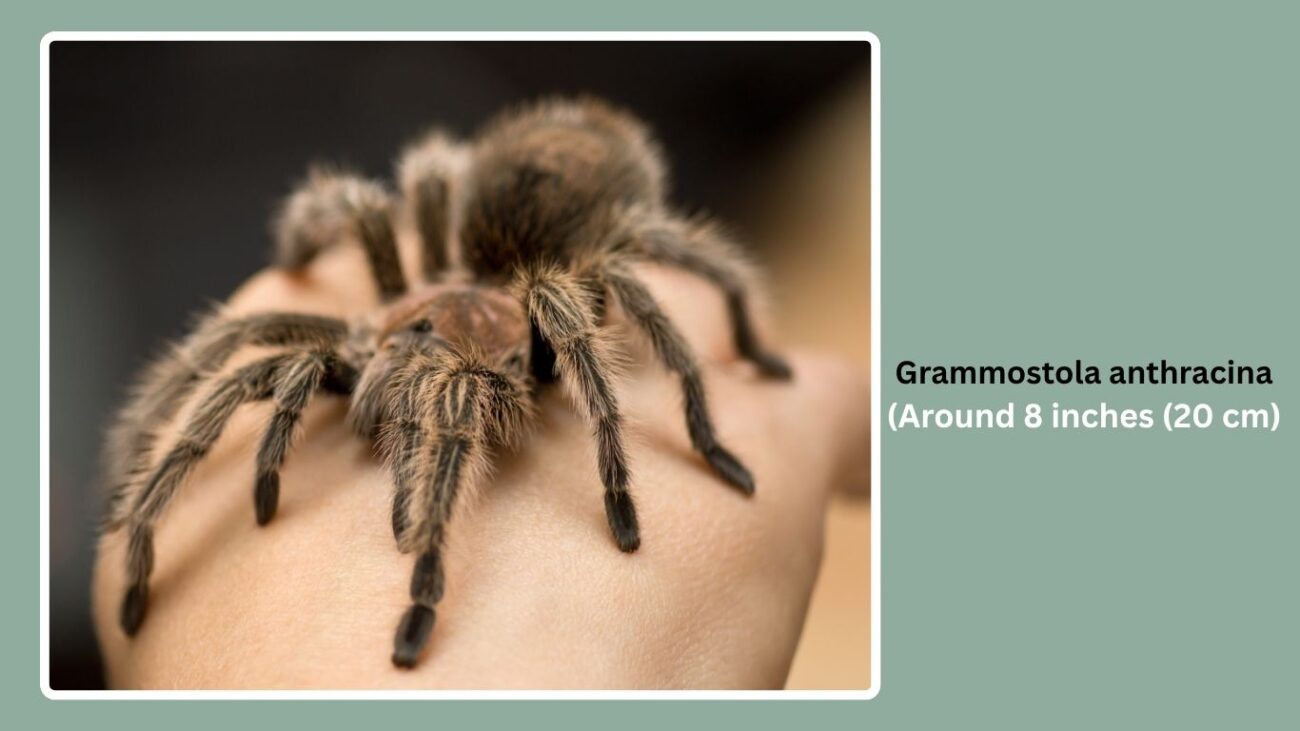
Grammostola anthracina is one of the larger tarantulas found in South America, known for its bulky body and calm temperament. Though not as massive as the Goliath or Salmon Pink Birdeater, it can still reach impressive sizes of up to 10 inches in leg span. Its dark, velvety body gives it a striking appearance, especially in dry habitats.
Identification
- Leg span: Up to 10 inches (25 cm)
- Body length: Around 3.5 inches (9 cm)
- Weight: Moderately heavy
- Color: Dark brown to black with a velvety texture
- Markings: Minimal, usually solid-colored
Habitat
Prefers open grasslands and dry forests, where it builds shallow burrows. It tolerates a wide range of temperatures and is often found in semi-arid areas.
Behavior
This species is relatively calm and slow-moving. It waits for prey to come near the burrow entrance, striking with speed when needed.
Region
Found in Uruguay, Argentina, and parts of Paraguay, particularly in open pampas and dry savannah zones, where the ground is firm but diggable.
5. Chaco Golden Knee Tarantula
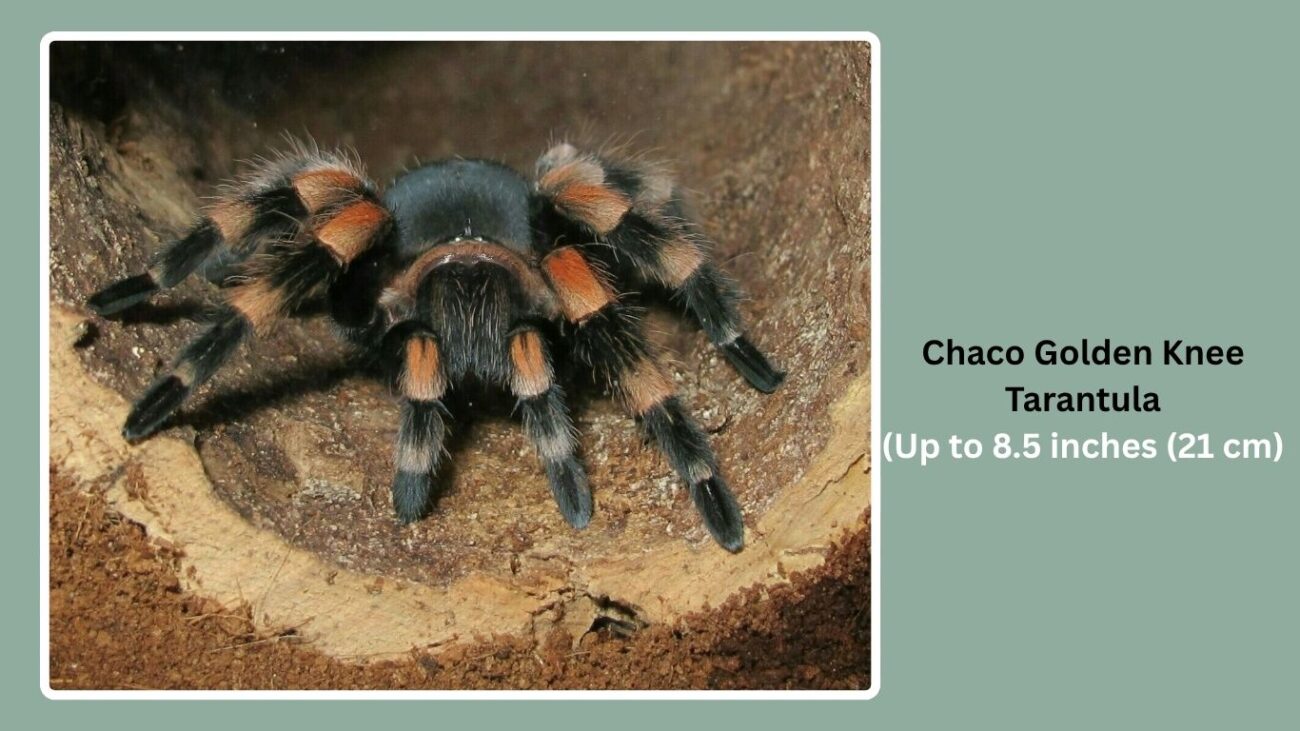
The Chaco Golden Knee Tarantula (Grammostola pulchripes) is famous for its large size and beautiful golden stripes on the knees. While its leg span can reach up to 8.5–9 inches, it is especially popular among tarantula keepers for its manageable nature and attractive appearance.
Identification
- Leg span: 8.5–9 inches (21–23 cm)
- Body length: Around 3–3.5 inches (7.5–9 cm)
- Weight: Medium to heavy
- Color: Brown with golden-yellow bands on the leg joints
- Texture: Hairy and robust
Habitat
Lives in humid grasslands and forest edges, often burrowing or hiding under natural debris. It prefers moist soil with moderate shelter.
Behavior
Non-aggressive and calm. It feeds on insects and small invertebrates. Its docile nature makes it one of the most beginner-friendly large tarantulas.
Region
Native to Paraguay and Argentina, especially in the Chaco region, where seasonal rains and open plains offer ideal burrowing conditions.
6. Colombian Giant Redleg Tarantula

The Colombian Giant Redleg Tarantula (Megaphobema robustum) is a large, striking species known for its reddish-orange legs and powerful build. With a leg span reaching up to 8.5 inches, it’s one of the heaviest tarantulas native to South America. Its thick limbs and defensive behavior make it a formidable presence in the wild.
Identification
- Leg span: Up to 8.5 inches (22 cm)
- Body length: Around 3 inches (7.5 cm)
- Weight: Heavy-bodied
- Color: Reddish-orange legs with a darker body
- Legs: Sturdy with thick femurs
Habitat
Prefers dense tropical rainforests where it lives in burrows or hides beneath logs and foliage. The high humidity of its environment supports its molting and growth.
Behavior
Unlike more passive tarantulas, this species may use its powerful hind legs to kick or intimidate threats. It preys on insects, amphibians, and small vertebrates.
Region
Native to Colombia and parts of Brazil, especially in lowland rainforest zones like the Amazonian foothills, where the ground is soft and covered with leaf litter.
7. King Baboon Spider
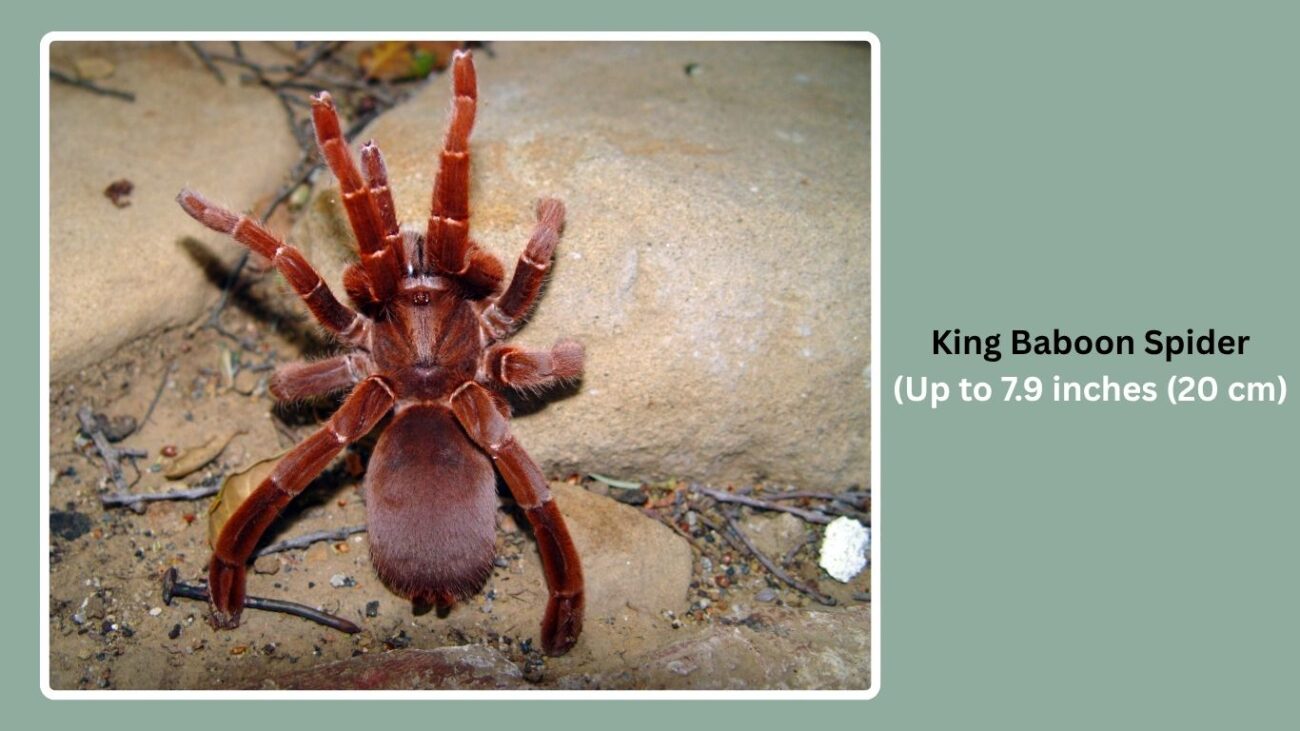
The King Baboon Spider (Pelinobius muticus) is a powerful and heavily built tarantula known for its thick legs and aggressive nature. With a leg span of up to 8 inches, it is the largest spider in East Africa. Unlike many others, it has a coppery-orange to rusty brown coloration and thick, armored limbs.
Identification
- Leg span: Up to 8 inches (20 cm)
- Body length: About 2.5–3 inches (6–7.5 cm)
- Weight: Thick and heavy
- Color: Rusty brown to coppery-orange
- Texture: Hairy with strong leg segments
Habitat
Lives in dry savannahs and scrublands, often creating deep, vertical burrows that can reach several feet underground. It thrives in arid climates with compact soil.
Behavior
Extremely defensive and reclusive. It rarely leaves its burrow and will hiss or rear up when threatened. It relies on strength and intimidation more than speed.
Region
Found in East Africa, especially Tanzania and Kenya, in dry, open landscapes with hard, burrow-friendly soil. These regions provide both the heat and dryness it prefers.
8. Camel Spider (Solifugae)
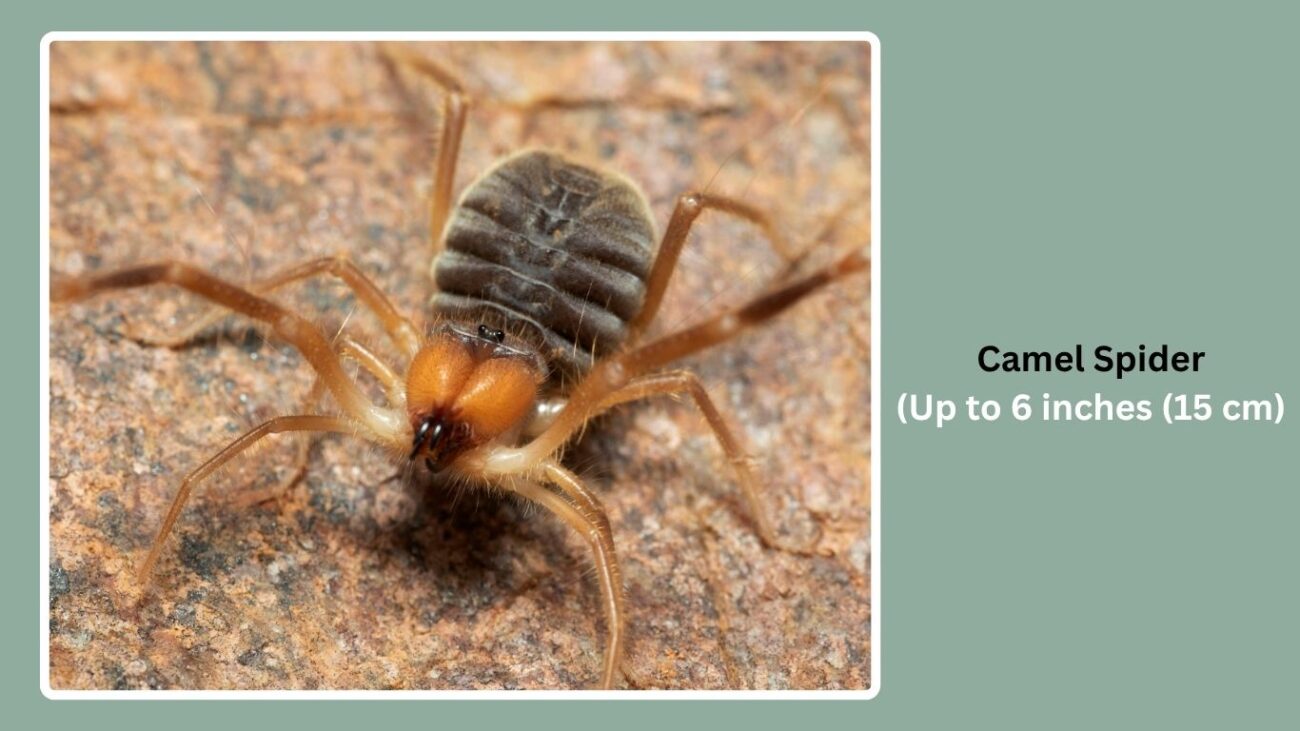
Though not a true spider, the Camel Spider is often included due to its massive size and spider-like appearance. These arachnids can reach leg spans up to 6 inches and have powerful, scissor-like jaws that make them fierce predators. Despite myths, they are not venomous but can deliver painful bites.
Identification
- Leg span: Up to 6 inches (15 cm)
- Body length: 2–3 inches (5–7.5 cm)
- Weight: Light to moderate
- Color: Tan or sandy brown for desert camouflage
- Jaws: Massive chelicerae (jaws), often half the body length
Habitat
Found in dry deserts and arid regions, often hiding under rocks or in burrows during the day and emerging at night to hunt.
Behavior
Fast and aggressive hunters, they chase down prey using speed. Their bite is strong but non-venomous. Known for their impressive sprinting ability.
Region
Widespread across Middle East, North Africa, and southwestern U.S., especially in hot, arid deserts like the Sahara and Arabian Peninsula, where they avoid extreme daytime heat.
9. Indian Ornamental Tarantula
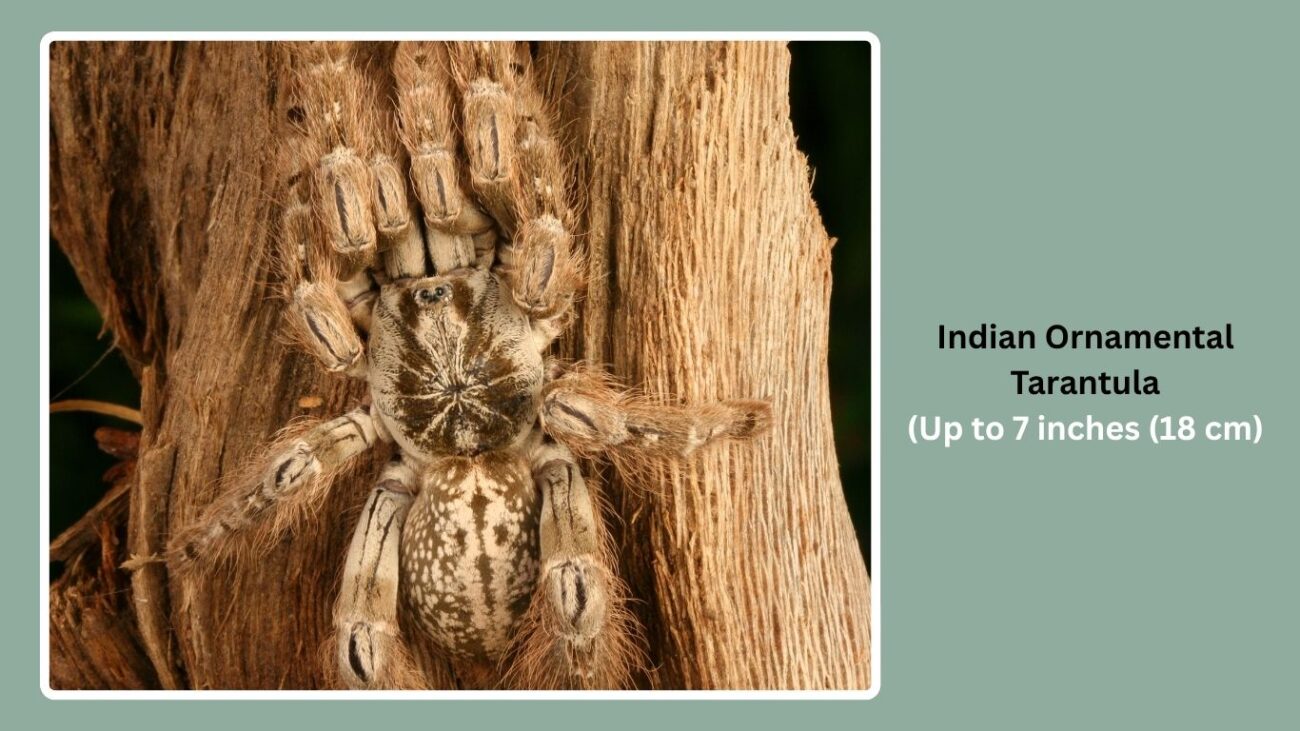
The Indian Ornamental Tarantula (Poecilotheria regalis) is a large, tree-dwelling species known for its stunning black, white, and grey patterns. Reaching leg spans up to 7 inches, it’s one of the largest arboreal tarantulas. Though beautiful, it is fast, defensive, and not recommended for beginners.
Identification
- Leg span: Up to 7 inches (18 cm)
- Body length: 2.5–3 inches (6–7.5 cm)
- Weight: Light and slender
- Color: Silvery grey with white and black patterns, yellow underlegs
- Markings: Intricate, lace-like patterns on abdomen and legs
Habitat
Inhabits tropical and subtropical forests, where it builds silk retreats in tree hollows, bark gaps, or abandoned nests.
Behavior
Extremely fast and defensive. Unlike ground tarantulas, it climbs and hides in vertical spaces. Feeds on insects, geckos, and small vertebrates.
Region
Endemic to southern India and Sri Lanka, particularly in moist deciduous and evergreen forests of the Western Ghats and Eastern Ghats, where tree cover is dense and humidity remains high.
10. Chinese Bird Spider

The Chinese Bird Spider (Haplopelma schmidti, also known as Cyriopagopus schmidti) is a large, burrowing tarantula with a leg span reaching up to 8 inches. Known for its aggressive temperament and potent venom, this spider is rarely handled and mostly observed in the wild or specialized collections.
Identification
- Leg span: Up to 8 inches (20 cm)
- Body length: Around 3 inches (7.5 cm)
- Weight: Medium to heavy
- Color: Dark brown to black with a robust body
- Fangs: Large and downward-pointing
Habitat
Lives in subtropical forests and grasslands, burrowing deep into the ground to stay cool and moist. It lines its burrow with silk and waits for prey at the entrance.
Behavior
Highly defensive and reclusive. It remains in its burrow most of the time and strikes quickly when provoked. Its venom is considered more toxic than most tarantulas.
Region
Native to southern China and northern Vietnam, particularly in forested provinces like Guangxi, Yunnan, and Hainan, where temperatures are warm and the soil supports deep burrowing.
11. Cobalt Blue Tarantula
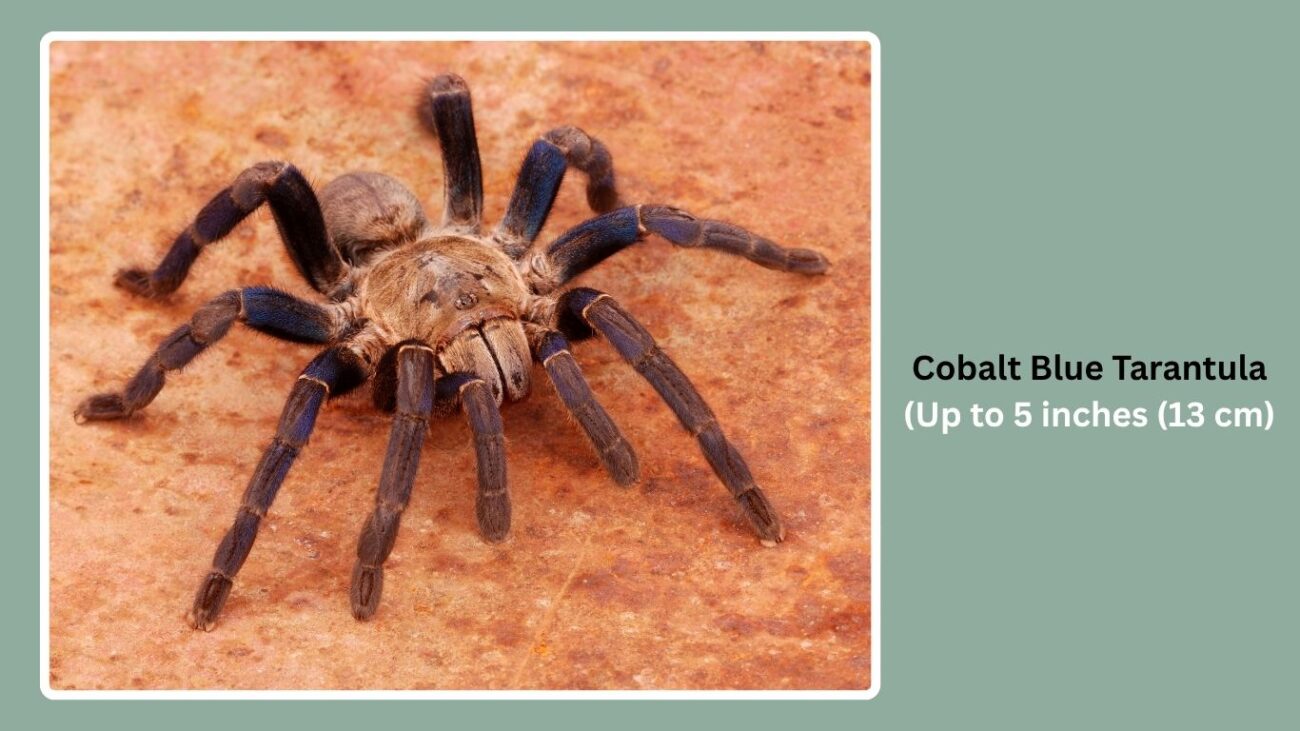
The Cobalt Blue Tarantula (Cyriopagopus lividus) is famous for its brilliant, metallic blue legs and large size, with leg spans up to 7 inches. It is a secretive, burrowing species that is both fast and defensive, making it a striking but challenging spider to keep.
Identification
- Leg span: Up to 7 inches (18 cm)
- Body length: About 2.5–3 inches (6–7.5 cm)
- Weight: Moderate
- Color: Deep metallic blue legs with gray or tan carapace
- Texture: Sleek and shiny
Habitat
Inhabits tropical rainforests and monsoon forests, where it digs long, silk-lined tunnels in moist soil to stay cool and humid.
Behavior
Extremely fast and secretive. It spends most of its time in burrows and emerges primarily at night to hunt insects and small animals.
Region
Found in Thailand, Myanmar, and surrounding parts of Southeast Asia, especially in lowland forest areas with rich, moist soil, where humidity and temperature are consistently high.
12. Togo Starburst Baboon Tarantula
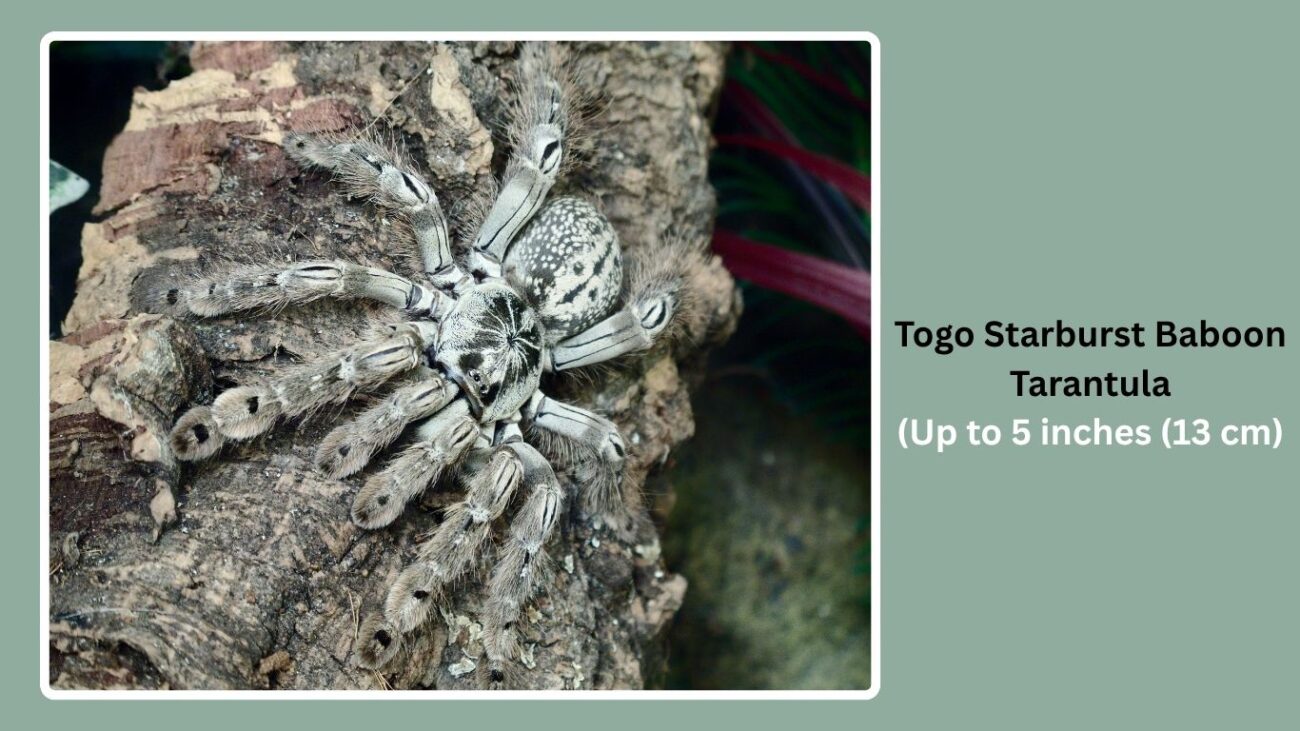
The Togo Starburst Baboon Tarantula (Heteroscodra maculata), also called the Ornamental Baboon Tarantula, is a fast and aggressive species with a striking pattern. Though lighter in body mass, it can reach up to 6–7 inches in leg span and is known for its lightning speed and strong climbing ability.
Identification
- Leg span: Up to 7 inches (18 cm)
- Body length: Around 2.5 inches (6.5 cm)
- Weight: Light to moderate
- Color: Pale grey with white starburst-like markings
- Texture: Velvety appearance with fine hair
Habitat
Lives in dry forests and rocky crevices, often climbing trees or sheltering in cracks. It constructs tube-shaped webs and hides during the day.
Behavior
Extremely fast, shy, and defensive. It avoids confrontation but will bite if cornered. It prefers high perches and tight hiding spaces.
Region
Native to Togo, Ghana, and parts of West Africa, especially in tropical and sub-Saharan forest zones where humidity is moderate and vertical hiding spaces are abundant.
13. Desert Blonde Tarantula
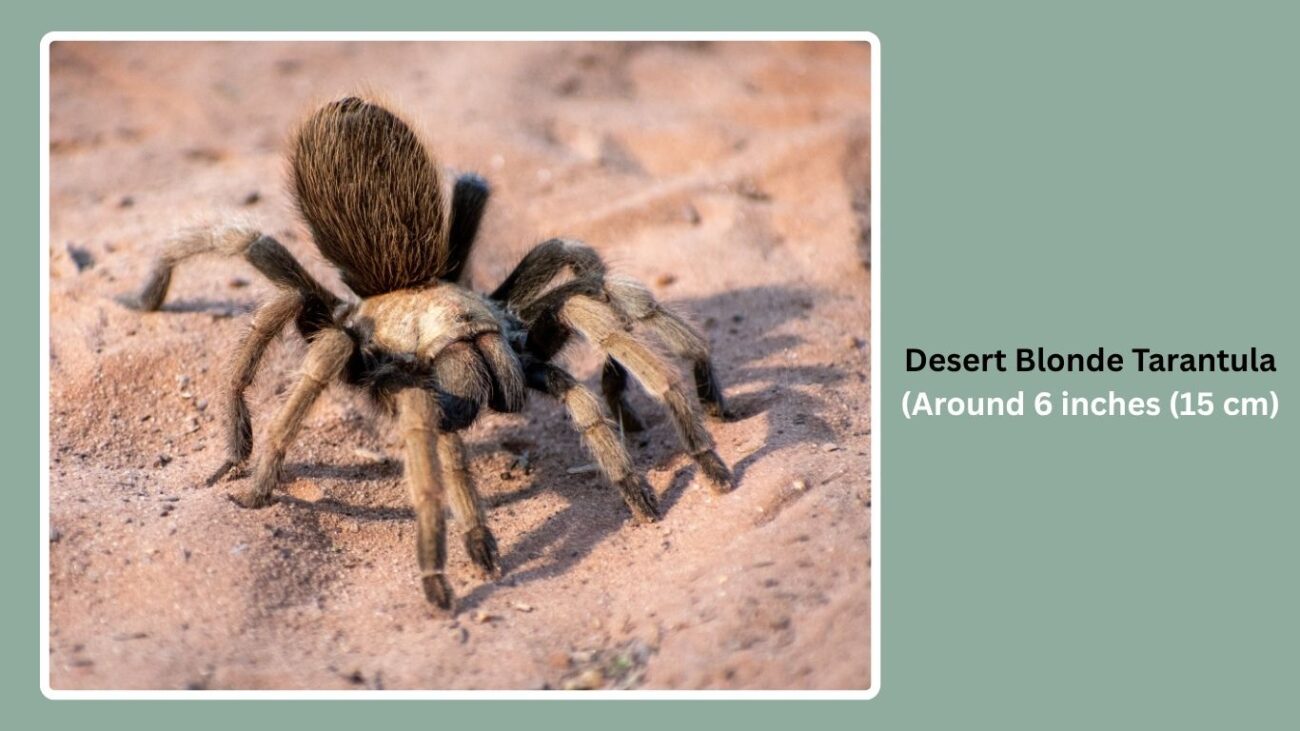
The Desert Blonde Tarantula (Aphonopelma chalcodes) is a large North American species that thrives in hot, arid environments. With a leg span of up to 6 inches, it’s one of the larger spiders found in the U.S., especially known for its blonde carapace and contrasting dark legs.
Identification
- Leg span: Up to 6 inches (15 cm)
- Body length: Around 2.5–3 inches (6–7.5 cm)
- Weight: Medium
- Color: Tan or blonde carapace, dark brown or black legs and abdomen
- Hair: Coarse and bristly
Habitat
Inhabits deserts and scrublands, where it digs deep burrows to escape the heat. Active mainly at night, especially during mating season.
Behavior
Docile and slow-moving. It rarely bites and often flees from threats. It feeds on insects and small desert creatures like crickets and beetles.
Region
Found in the southwestern United States, especially Arizona, New Mexico, and parts of Mexico, in Sonoran and Chihuahuan Desert regions where the ground is sandy and well-drained.
14. Pinktoe Tarantula
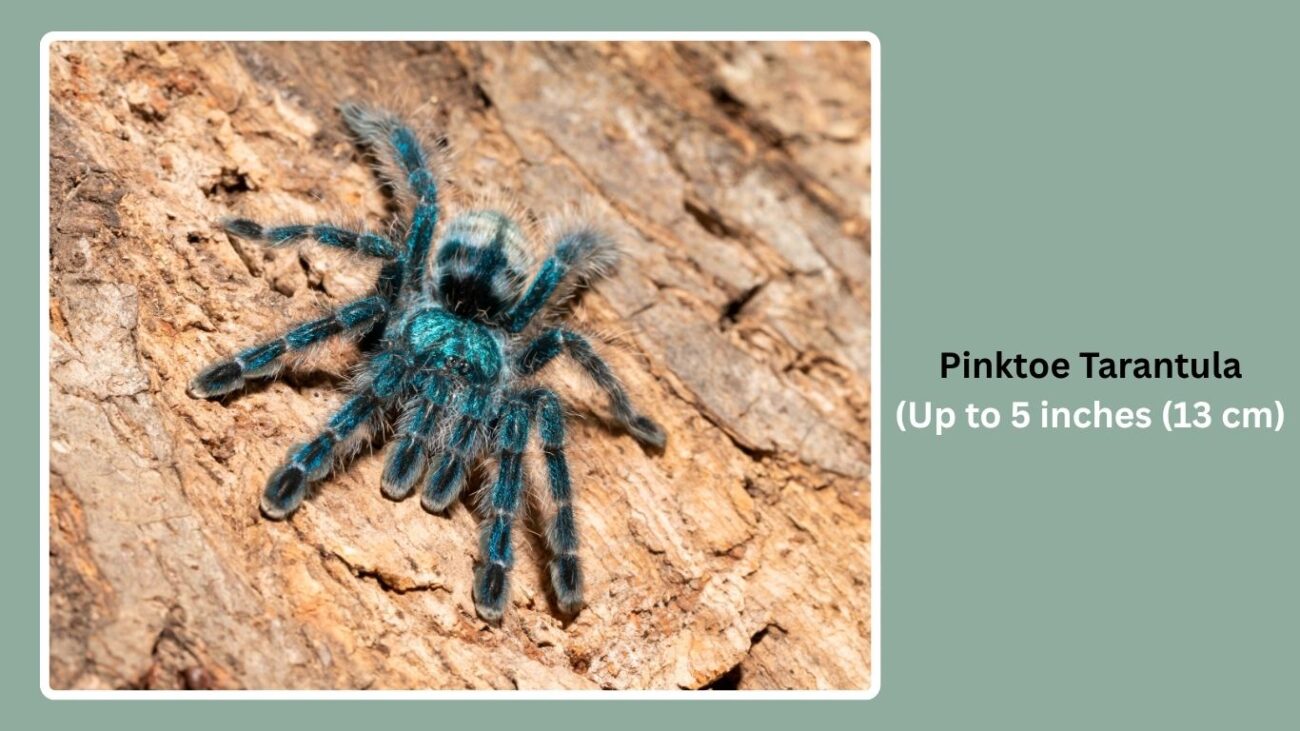
The Pinktoe Tarantula (Avicularia avicularia) is a large, tree-dwelling spider known for its fuzzy appearance and distinct pink tips on its legs. While it has a lighter frame than other large tarantulas, its leg span can reach up to 6 inches. It’s one of the more docile species and is often kept as a pet.
Identification
- Leg span: Up to 6 inches (15 cm)
- Body length: Around 2–2.5 inches (5–6.5 cm)
- Weight: Light
- Color: Dark brown to black body with pink or reddish toes
- Texture: Very hairy, soft appearance
Habitat
Lives in rainforests and humid tropical areas, primarily in trees. It creates silken retreats in tree hollows or among leaves, rather than digging.
Behavior
Docile and shy. It prefers to escape rather than defend itself and uses its agility to climb. It can also jump short distances when startled.
Region
Native to northern South America, including Brazil, Suriname, French Guiana, and Venezuela, especially in humid rainforest canopies where trees provide shelter and moisture.
15. Mexican Redknee Tarantula
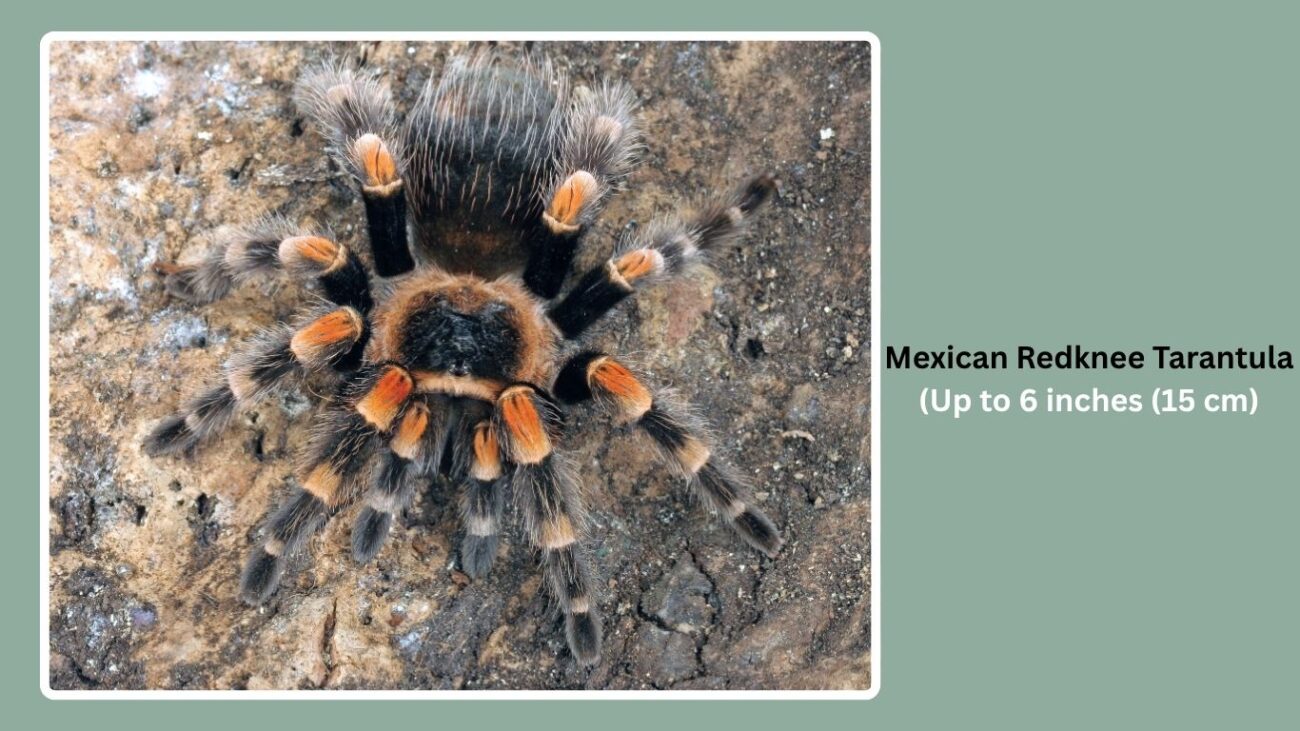
The Mexican Redknee Tarantula (Brachypelma hamorii) is famous for its striking black body and bright red-orange knees. It’s moderately large, with a leg span of up to 6 inches, and is one of the most iconic tarantulas due to its frequent appearance in media and movies.
Identification
- Leg span: Up to 6 inches (15 cm)
- Body length: Around 2.5–3 inches (6–7.5 cm)
- Weight: Medium
- Color: Black body with vibrant red-orange joints on legs
- Texture: Glossy, bristly body
Habitat
Found in semi-desert and scrubland environments, where it burrows or hides under rocks and logs. It prefers drier climates with occasional rainfall.
Behavior
Very calm and slow-moving. Known for being one of the best tarantulas for handling due to its docile nature and tolerance for interaction.
Region
Native to western Mexico, especially states like Guerrero and Michoacán, in dry shrublands and arid foothills where the climate is warm with seasonal rain.
16. Costa Rican Zebra Tarantula
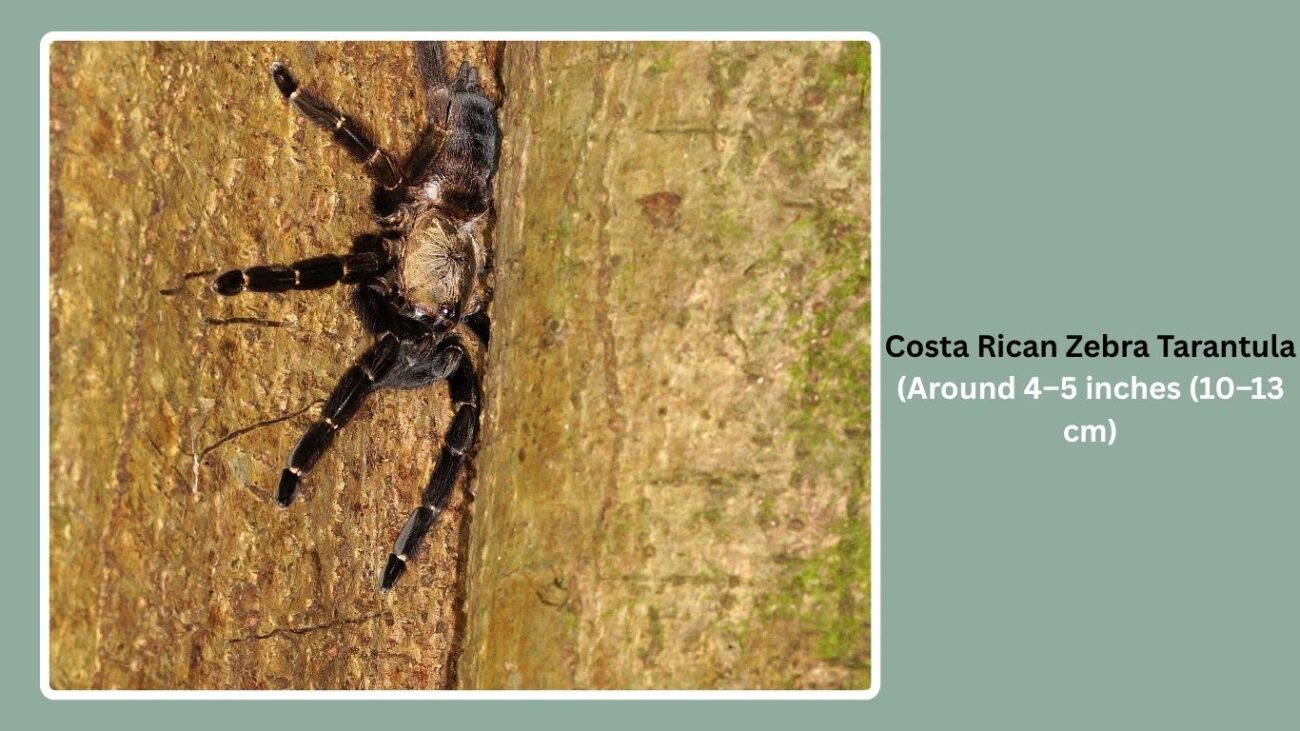
The Costa Rican Zebra Tarantula (Aphonopelma seemanni), also known as the striped-knee tarantula, is admired for its bold white striping on dark legs. It has a leg span of up to 5.5–6 inches and is moderately bulky. Its striking appearance and manageable temperament make it popular among tarantula enthusiasts.
Identification
- Leg span: 5.5–6 inches (14–15 cm)
- Body length: Around 2.5 inches (6–6.5 cm)
- Weight: Medium
- Color: Dark brown to black with prominent white stripes on the legs
- Texture: Smooth with visible hair
Habitat
Prefers humid forests, savannahs, and grasslands, where it burrows in soft soil and hides under leaf litter or logs. It needs moderate moisture and ventilation.
Behavior
Generally calm and skittish rather than aggressive. It’s a burrower and stays close to its shelter. It may bolt when startled but rarely shows threat behavior.
Region
Found in Costa Rica, Honduras, and Nicaragua, particularly in lowland rainforests and forest edges where rainfall is regular but the environment allows for dry-season burrowing.
17. Antilles Pinktoe Tarantula
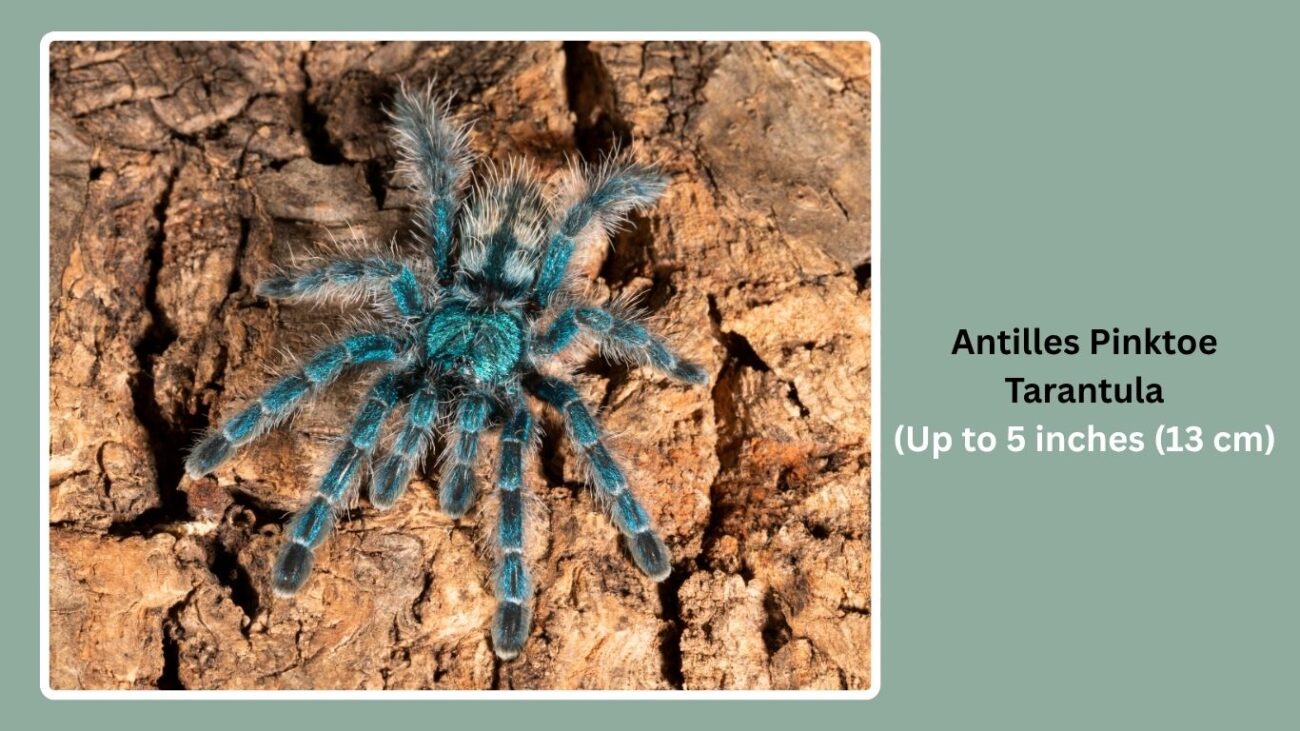
The Antilles Pinktoe Tarantula (Caribena versicolor) is a vibrantly colored arboreal species from the Caribbean. While slightly smaller than other large tarantulas, its leg span still reaches around 5.5 inches. Juveniles are bright blue, and adults develop a green and pink iridescent look, making them among the most beautiful tarantulas.
Identification
- Leg span: Up to 5.5 inches (14 cm)
- Body length: About 2 inches (5 cm)
- Weight: Light
- Color: Adults show green-blue with pink hues; juveniles are metallic blue
- Texture: Fuzzy and brightly colored
Habitat
Lives in tropical island forests, creating silken retreats in trees, shrubs, or crevices. It avoids the ground and prefers higher vegetation.
Behavior
Fast, jumpy, but generally not aggressive. Known for producing thick silk webs in elevated areas and having excellent climbing ability.
Region
Native to Martinique and other islands in the Lesser Antilles, thriving in humid, coastal forests and tropical highland zones, where vegetation is dense and temperatures remain warm year-round.



